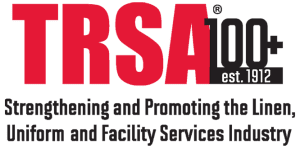Hygienically Clean Nears 60-Plant Threshold
Four textile services facilities recently have certified their operations with TRSA’s Hygienically Clean Healthcare program. This brings the total number of facilities in compliance with the designation’s rigorous protocols for quality assurance (QA) to 56 in the 2.5 years since the first such certification was issued.
 The latest designees include:
The latest designees include:
- Hassler Textile Services, Connersville, IN
- United Linen Services-New England, Lawrence, MA
- Metro Linen, McKinney, TX
- Crothall Laundry Services-Maryland, Belcamp, MD
Receiving the Hygienically Clean Healthcare certification hinges on laundries’ QA efforts ensuring that best management practices (BMPs) are documented and followed for the production of hygienically clean textiles. These practices encompass applicable infection-control guidelines, including those established by the Centers for Disease Control and Prevention (CDC) as well as recommended practices from The Joint Commission (TJC – formerly JCAHO) relevant to the handling and processing of healthcare textiles. Bacteriological testing verifies the effectiveness of these practices.
Chief among certification requirements, TRSA inspects facilities seeking the designation for QA documentation and other evidence that BMPs in the following categories are implemented:
- Plant Facilities: including functional separation of soiled and clean areas, equipment maintenance and calibration
- Housekeeping: use, cleaning and care of equipment; cleaning of carts, work surfaces and stations; selection, measurement and proper use of cleaning supplies; cleaning schedule
- Laundry Process: soiled linen handling, washing and drying procedures, transportation, delivery
Microbial testing verifies that laundry processes achieve the necessary outcome of product hygiene. In addition to passing an inspection to clear the initial thresholds of the Hygienically Clean certification, facilities must submit laundered textiles to an independent, TRSA-approved laboratory for bacteriological testing. The samples must pass testing on three consecutive rounds.
After qualifying, facilities then must pass regularly scheduled testing to maintain the Hygienically Clean Certification. Protocols include the Replicate Organism Detection and Counting (RODAC) quarterly for total microbial content and United States Pharmacopeia (USP) 62 semi-annually for specific microorganisms.
Overseeing this TRSA program is the Hygienically Clean Advisory Board, consisting of professionals encompassing the full spectrum of healthcare laundry, including commercial launderers, nurses, doctors, chemical manufacturers and research scientists, many of whom were drawn from TRSA’s membership ranks due to their industry knowledge and expertise.
“The (Hygienically Clean Certification) Program is technically sound and would be a good first step in assuring continued quality control in commercial laundries,” said Professor Kellogg J. Schwab, of the Department of Environmental Health Sciences at Johns Hopkins University (JHU) Bloomberg School of Public Health, Baltimore, and director of JHU’s Water Institute. Professor Schwab was consulted to confirm the testing protocols used in the certification program are significant and appropriate.
Nearly 40 additional laundry facilities are currently clearing the initial thresholds of the Hygienically Clean Healthcare certification, with 13 of them having passed the microbial testing requirements and awaiting inspection of their laundries.
